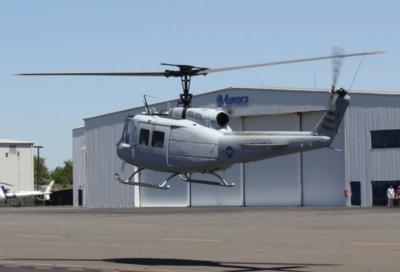Final Test Flight Conducted At Quantico
Autonomy options for the Marine Corps have taken a major step forward, as officials at the Office of Naval Research (ONR) announced a successful final helicopter flight demonstration with autonomous capability at Marine Corps Base Quantico, VA, part of the Autonomous Aerial Cargo/Utility System (AACUS) program. AACUS is a partnership between ONR and technology company Aurora Flight Sciences.

AACUS will enable the Marine Corps to rapidly resupply forces on the front lines using cutting-edge technology sponsored by ONR. The system consists of a sensor and software package that can be integrated into any manned or unmanned rotary-wing aircraft to detect and avoid obstacles (like telephone wires, other vehicles or large ground objects) in unfavorable weather conditions, or to facilitate autonomous, unmanned flight. This capability will be a welcome alternative to dangerous convoys or manned aircraft missions in all types of weather.
“This is more than just an unmanned helicopter,” said Dr. Walter Jones, ONR executive director. “AACUS is an autonomy kit that can be placed on any rotary-wing platform and provide it with an autonomous capability. Imagine a Marine Corps unit deployed in a remote location, in rough terrain, needing ammunition, water, batteries or even blood.
“With AACUS, an unmanned helicopter takes the supplies from the base, picks out the optimal route and best landing site closest to the warfighters, lands, and returns to base once the resupply is complete—all with the single touch of a handheld tablet.”
The need for this capability surfaced during Marine Corps operations in Afghanistan and Iraq, experts say. Cargo helicopters and resupply convoys of trucks bringing fuel, food, water, ammunition and medical supplies to the front lines frequently found themselves under fire from adversaries—or the target of roadside bombs and other improvised explosive devices.
AACUS is designed for simple use; an operator with minimal training can call up the supplies needed and order the flights using only an intuitive handheld tablet. During the Dec. 13 demonstration tests at Quantico, a Marine with no prior experience with the technology was given a handheld device and 15 minutes of training.
The Marine was able to quickly and easily program in the supplies needed and the destination, and the helicopters arrived quickly—even autonomously selecting an alternative landing site based on last-second no-fly-zone information added in from the Marine. The demonstration featured a UH-1 “Huey” flying autonomously on multiple missions.
“We’ve developed this great capability ahead of requirements and it’s up to us to determine how to use it,” said Lt. Gen. Robert Walsh, commanding general, Marine Corps Combat Development Command. “The young Marines today have grown up in a tech-savvy society, which is an advantage. We’ve got to keep pushing and moving this technology forward.”
Officials say AACUS represents a leap-ahead technology for the Marine Corps and Navy, moving unmanned flights far beyond the current standard, which requires a specialized operator to select a landing site and manually control an unmanned aircraft via remote.
“AACUS gives revolutionary capability to our fleet and force,” said Dennis Baker, AACUS program manager. “It can be used as a pilot aid to operate in GPS- and communications-denied arenas, or allow fully autonomous flights in contested environments—keeping our pilots and crews out of harm’s way.”
(Image provided by Aurora Flight Sciences)
 Airborne-NextGen 11.04.25: Anduril YFQ-44A, Merlin SOI 2, UAV Rulemaking Stalled
Airborne-NextGen 11.04.25: Anduril YFQ-44A, Merlin SOI 2, UAV Rulemaking Stalled NTSB Prelim: Elmore Travis C Searey
NTSB Prelim: Elmore Travis C Searey ANN's Daily Aero-Linx (11.03.25)
ANN's Daily Aero-Linx (11.03.25) ANN's Daily Aero-Term (11.03.25): On-Course Indication
ANN's Daily Aero-Term (11.03.25): On-Course Indication Aero-News: Quote of the Day (11.03.25)
Aero-News: Quote of the Day (11.03.25)



